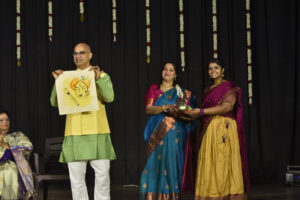The Bharatanatyam Arangetram ceremony is more than just a dancer’s first solo performance—it is a deeply cultural and spiritual milestone that reflects years of training, discipline, and devotion to the art form. For every student of Bharatanatyam, this occasion represents the moment they step onto the stage with confidence, embracing their identity as an artist. Beyond a performance, it is a rite of passage that connects the dancer to tradition, community, and heritage. Every dancer should experience this ceremony because it highlights not only technical mastery but also a lifelong bond with the dance form and the values it imparts.
1. Defining Arangetram
The word “Arangetram” originates from Tamil, meaning “ascending the stage.” In the context of Bharatanatyam, it is the dancer’s debut solo performance after years of rigorous practice. It is not simply about showcasing skill but about symbolizing readiness to present the art form independently. Through intricate footwork, graceful mudras, and expressive abhinaya, the dancer demonstrates the culmination of their learning. This stage debut becomes the bridge between being a student and stepping into the role of an independent performer in the classical dance world.
2. What is Arangetram Ceremony?
To understand what is Arangetram ceremony, one must see it as a symbolic graduation in Bharatanatyam. It is often the culmination of six to ten years of dedicated training under the guidance of a guru. During the event, the dancer presents a full repertoire of Bharatanatyam pieces that include alarippu, jatiswaram, varnam, padams, and tillana, each showcasing rhythm, storytelling, and emotion. The Bharatanatyam Arangetram procedure involves not just the performance but also months of preparation, including costume selection, live music arrangements, stage décor, and rehearsals. The event is both personal and communal—celebrated with family, friends, and patrons of the arts.
3. The Cultural Significance
The Bharatanatyam Arangetram history is deeply rooted in tradition. Historically, Bharatanatyam was performed in temples as an offering to deities. The Arangetram thus carries forward this legacy, symbolizing devotion and service to art and divinity. Today, while it is celebrated on public stages, its spiritual significance remains intact. It is not only a personal achievement for the dancer but also an act of cultural preservation. By performing their Arangetram, dancers honor their gurus, ancestors, and the timeless wisdom of the Natya Shastra, ensuring that this ancient dance form thrives across generations.
4. Bharatanatyam Performance in Context
In the context of Indian classical dance, the Bharatanatyam Arangetram is a unique milestone that blends personal growth with cultural continuity. It provides dancers with a platform to connect with audiences through storytelling rooted in mythology, devotion, and human emotion. Unlike casual performances, the Arangetram requires the dancer to present a complete repertoire, testing their stamina, versatility, and emotional depth. It also reinforces the importance of discipline, resilience, and humility—qualities that extend far beyond the stage into everyday life.
5. Preparation and Expectations
Preparing for an Arangetram is a meticulous process that involves months of hard work. From physical stamina to emotional readiness, the dancer must be equipped to sustain a two- to three-hour solo performance. The Bharatanatyam Arangetram procedure includes perfecting adavus, refining expressions, and synchronizing with musicians. Costumes and jewelry are carefully chosen to reflect tradition, while stage arrangements create the divine ambience of Bharatanatyam. Families also play a crucial role by supporting the dancer emotionally and logistically. Expectations are high, but the process teaches patience, discipline, and perseverance.
6. Student Performances: A Journey to the Stage
Every student’s Arangetram is a journey of transformation. Typically, the Bharatanatyam Arangetram age ranges from early teens to young adulthood, depending on the dancer’s progress and the guru’s approval. It represents the culmination of years of consistent practice, often beginning in childhood. The student’s performance is not just a showcase of technique but also a reflection of their devotion to the art. Families and communities celebrate this moment with great pride, often presenting the dancer with Bharatanatyam Arangetram gifts such as symbolic jewelry, idols, or keepsakes that honor their cultural achievement.
7. Role of the Dance Guru
No Arangetram can take place without the unwavering guidance of the dance guru. The guru is not just a teacher but a mentor who imparts discipline, values, and cultural wisdom alongside technique. In the Bharatanatyam Arangetram history, the guru-shishya parampara (teacher-student tradition) is at the core of classical dance education. The guru decides when the student is ready for Arangetram, ensuring that the dancer embodies both technical mastery and spiritual maturity. On the day of the performance, the guru’s presence symbolizes blessings and guidance, reinforcing the sacredness of the event.
8. Audience Engagement
The audience plays a vital role in the Arangetram, as they are the recipients of the dancer’s offering. The performance is designed not only to showcase the dancer’s skill but also to move the audience emotionally and spiritually. Each piece tells a story—from invocations to deities to expressive padams that explore human emotions. The engagement between dancer and audience creates a shared cultural experience, strengthening community ties. For many, witnessing a Bharatanatyam Arangetram is an introduction to the beauty of classical dance, inspiring new learners and cultivating appreciation for tradition.
9. Conclusion
The Bharatanatyam Arangetram is not just an event but a transformative journey that shapes the dancer’s identity and honors cultural heritage. Through months of preparation, mentorship from gurus, and the spiritual essence of the performance, the Arangetram marks the dancer’s evolution from student to artist. From understanding the Bharatanatyam Arangetram history to recognizing the importance of the Bharatanatyam Arangetram age and procedure, this milestone remains central to the preservation of Bharatanatyam. With meaningful Bharatanatyam Arangetram gifts, the ceremony becomes a celebration of both personal growth and cultural continuity. Every dancer who experiences Arangetram not only embraces tradition but also ensures that the timeless magic of Bharatanatyam continues to inspire future generations.





